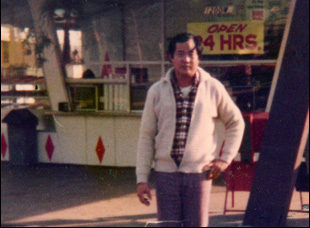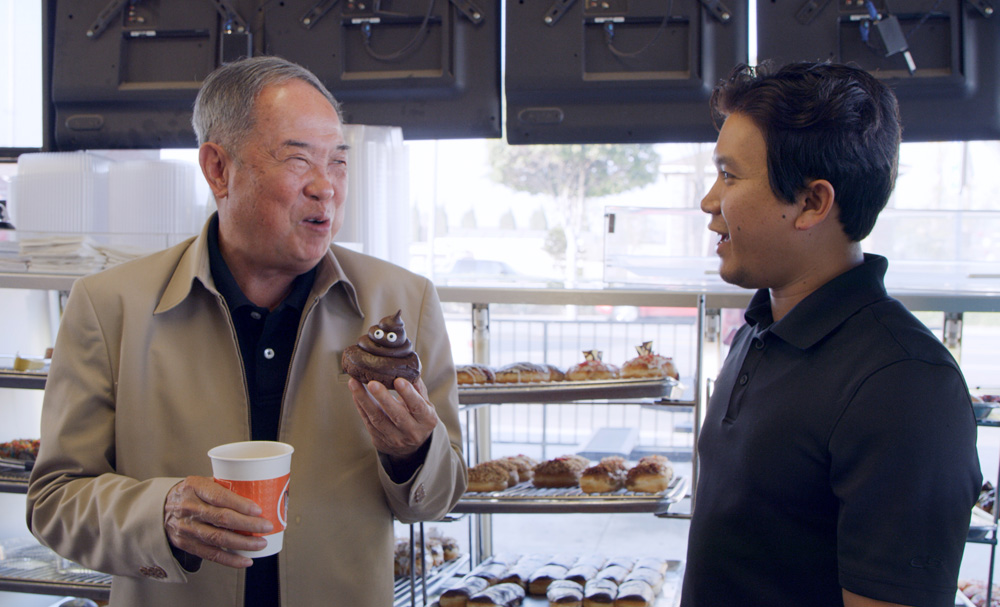After nine months of anticipating a new baby, Alice Gu was unaware that she soon would be giving birth to a film.
“I feel like sometimes the best things come when you’re not looking for them,” said Gu, who had just hired a nanny to help take care of her newborn while she was planning a return to work as a director of photography. After her husband brought home a box of donuts from a high-end bakery in Los Angeles, the nanny thought she could do one better, insisting that Cambodians make the best donuts in the city and as it turns out, she didn’t need to look far to find one when over 90% of the shops in the area are Cambodian owned and operated.
“I wasn’t looking for a documentary idea at all, [but when I learned that I’m like, ‘Whaaaat?!?!” recalls Gu. “I grew up in L.A. I’m familiar with the pink boxes. It was that eye-opening, lightbulb-going-off-in-your-head moment of “Whoa, this is so wild. I’ve got to tell this story.”
The story turned out to be even wilder than Gu could’ve ever imagined after locating Ted Ngoy, the “Donut King” after which her debut feature is named. The filmmaker tracks the remarkable personal tale of the man who cornered the market on fried dough in Southern California after fleeing Phnom Penh during the 1970s when the Khmer Rouge took power and allowed to enter America under the Indochina Migration and Refugee Act, but finds an even more incredible story in the legacy he built for other Cambodians who had to relocate and create new lives for themselves in the U.S. After finding sponsorship from a church in Sylmar to leave the refugee camp and taking training at a Winchell’s to operate one of their storefronts, Ngoy extended both the education and ability to sponsor others to give Cambodians like himself a sustainable business making donuts, outfoxing competitors — preventing Dunkin’ Donuts from even trying to move in on the territory — with the lower labor costs of being family run and savvy innovations such as pink cardboard boxes (which were actually cheaper than buying the more popular white).
Yet Ngoy’s success was anything but straightforward and Gu shows remarkable skill at handling a complicated family saga, not only within her subject’s once close-knit clan, but at large when hard work of immigrants looking to make a better life for the next generation pays off to the extent that their kids may have grander ambitions than taking over their business. Still, there’s always considerable allure with donuts around and not only does the director find the beauty in all the glazed wonders she sees all across Los Angeles at bakeries such as DK’s Donuts in Santa Monica, Rose in Temple City and BC’s in Pasadena, but in how immigrants adapt and contribute to American life.
Despite being deprived of a proper premiere at South by Southwest where it was scheduled to premiere before the festival was cancelled by the coronavirus, “The Donut King” itself has rolled with the punches, given a Special Jury Award from the folks in Austin before collecting similar honors at Bentonville and Sun Valley, which went online and now the film is being offered up this Halloween weekend in virtual cinemas for anyone who needs something sweet in their life right now. On the eve of the film’s release, Gu graciously spoke about how she went about structuring such a complex narrative, marshaling archival material when inherently it would be difficult to come by when its subject had to leave so much behind, and how so many were able to tell a personal story through making a film about Ngoy.

Yes and no. When I first read the articles, that very first day when I decided to tell this story, it was more of a biopic and [I thought], “Well, this guy’s story super-interesting from the time he’s born until now when he’s 80 years old.” But as I started to get into why this story was important to tell, I felt we needed to include the stories the younger generation, like the kids of these immigrants who take over their parents’ donut shops and innovate them to the 21st century with social media and Instagram videos, really bringing the donut shops from their parents’ shop into something modern with followings all over the world. So it ended up becoming layered where we told [Ted’s] story, but we were able to tell these substories of different characters.
From what I understand, a number of people that worked on the film could relate to the story, coming from the families of immigrants. Did you feel you could tell a personal story through this larger one?
When I set out to make the film, I was like, “Oh cool, this is an Asian story and I’m Asian, so this is a really Asian story,” but my producer Jose is Colombian and he came here when he was 12, and my editor Carol, she’s American through and through, but of Italian and Jewish descent and she’s like, “Oh yeah, my grandparents [came through] Ellis Island and started with two produce carts and now we have a farm in Arizona.” So the realization set in that, except for Native Americans, everybody is an immigrant to this country, and everybody has a story of someone in their family back then who was the first one paving the way and going for a better life for themselves.
I am the kid of immigrants myself, so I had an understanding of having a foot in both worlds and seeing how hard your parents work. You’re dying to be more American like all my friends in school and while [my parents] didn’t own donut shops where it’s like “work, work, work,” I had to go to Chinese school on Saturdays and [I’d say], “No, these kids are watching Saturday morning cartoons, and good grief, why can’t we be like everyone else?” What made it so personal for me was a deeper understanding of the immigrant experience — what it means to come here to a new land, unfamiliar with the language and the customs, and they don’t have a big support network here – they’re building everything from scratch so their kids can have a better life than they did — that I really got out of this film and I hope people [watching it] will too.

There was so little. I’m really glad it comes across as there’s a lot because they had all these different photo albums, but when I went to look through them at first, I had in my mind, all these docu-style [pictures] of “Oh there [Ted] is with the 40-pound bag of flour” and “There they are at the donut shop,” but then I realized when you’re an immigrant coming here and you have a camera with film that’s expensive, being in the donut shop is the least glamorous part of what you want to be remembering. So they had pictures in Las Vegas and Yosemite and Big Bear when they had money and were traveling to Europe because those were the good times, but anything in the donut shop we didn’t have hardly any at all.
[I’d start] imploring all family members, [saying] “It has to be somewhere. Somebody must have that one picture in the donut shop.” Eventually, we started to get a few donut shop pictures, but a lot of the archival, especially the stuff that was back in Cambodia, was gone because it was such a crazy time, so Ted actually didn’t have a lot of them. A lot of the pictures we found from family members of family members and I would show them to Ted and he would say, “I’ve never been shown this picture before in my life.” He’d [say], “This is incredible,” so that was pretty neat. [And with] the archive that I lacked, [thinking] “Oh God, we don’t have any pictures of Christy’s mansion” or “we don’t have any pictures of Ted,” it’s like how do we tell this in a visually compelling way, so I thought animation would be the best tool to do this. I really wanted to find a Cambodian artist and I started asking around with some friends and a friend of a friend said, “Do you know Andrew [Hem]’s work? He’s incredible.” I was blown away by his watercolor work, his technique is just incredible – it has such a distinct style, it looks like nobody else’s — so I reached out to him and he said, “I’m familiar with this story. I’m a donut kid myself. I worked at my parents’ shop since I was a kid.” So I thought, “Wow, here is somebody who makes a living as a fine artist, who went to Pasadena Art Center, one of the best art schools in the world, and the kid of refugees who worked in a donut shop can end up pursuing his dreams and living a creative life.” I just thought that was so wonderful and it could be nobody else but him.
What really took me by surprise was our own U.S. history. I can’t even say that I had even a casual understanding of past immigration or refugee policy of past presidents, but in doing that research finding the [Indochina] Refugee Act passed by President Ford, whose speech is in the film, that’s the first and only time in U.S. history a president issued an executive order to receive refugees. And given the nature of politics in the last four years to eight years, I was very surprised. I was like, “Oh my God, it was a Republican president who issued the order to have refugees come,” and being in California [with] Jerry Brown being our recent governor, who I’ve seen as a beacon of light and hope and having a good moral compass, saying the complete opposite, “I’m very reluctant to bring these people into our country when Californians are out of work and unemployment is high,” when he was governor of California for the first time in 1975, so it’s the same kind of rhetoric you’re hearing from the Republican Party these days, but everything was completely flip-flopped in 1975.
What’s it like to be releasing the film in this particular moment?
It’s exciting and it’s a little bit strange to do it in 2020. It’s not the year I thought I would have when I got accepted into SXSW in January, and that was a hugely exciting moment and also panic because we weren’t expecting to get in. We submitted so late, we weren’t ready, so I went to everybody like, “Hey, do you remember that six-week timeline we had to finish the film? It’s now three weeks.” And everybody just went at it. Everybody did the grind and we worked together so solidly for his common goal and we would get to celebrate at South By. We never got to do that. In fact, I haven’t seen most of any of these people in months, so it’s a vastly different year than we thought it would be. At the same time, I feel like the art of cinema is strong and there’s so many wonderful and innovative ways that festivals and theaters and producers have thought of ways to pivot, so that films can still be released and seen. I’m just honored that we’re going to have a release this year and I’m excited.
“The Donut King” opens on October 30th in virtual cinemas and on digital.




